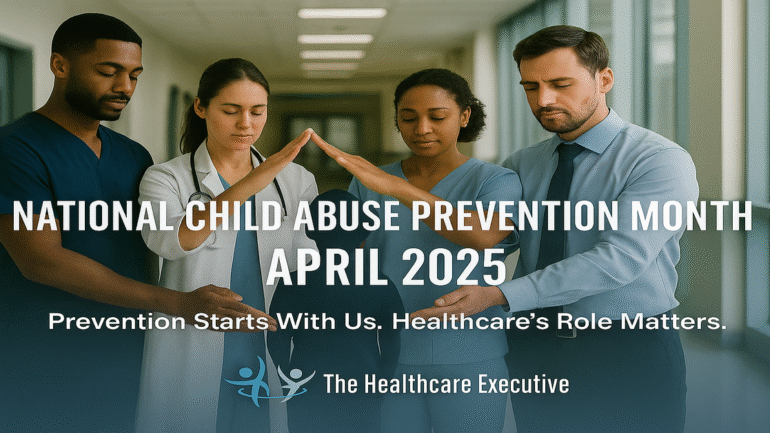National Child Abuse Prevention Month – April 2025

- Posted by Greg Wahlstrom, MBA, HCM
- Posted in Health Observance Calendar
Prevention Starts With Us. Healthcare’s Role Matters.
Published: April 1, 2025
April marks National Child Abuse Prevention Month, a critical time to elevate the role of healthcare professionals in protecting vulnerable children. While abuse is a difficult topic, the discomfort of addressing it pales in comparison to the consequences of inaction. Healthcare providers are often the first point of contact for children suffering in silence, making early recognition and reporting essential. Every nurse, physician, and technician must be trained to identify behavioral, physical, and emotional indicators of abuse. This is not merely a clinical skill—it is a moral imperative. Pediatric settings in particular should incorporate standardized screening questions into every intake. Evidence-based protocols and trauma-informed training should be universal across all departments, not siloed to pediatrics or emergency medicine. At the systems level, executives must ensure reporting tools are intuitive, accessible, and integrated into EHR workflows. Organizations like the American Academy of Pediatrics offer resources to support these efforts. When healthcare acts as a unified front, prevention becomes protection.
Child abuse occurs in every community and across every socioeconomic status, making vigilance essential in all clinical settings. The Centers for Disease Control and Prevention (CDC) reports that at least 1 in 7 children experienced abuse or neglect last year in the United States. Yet this number is widely believed to be underreported, due in part to systemic blind spots in detection. Clinical teams must work collaboratively with social workers and family advocates to break through these blind spots. At Rady Children’s Hospital in San Diego, a dedicated Child Protection Program evaluates high-risk cases using real-time consultation and multi-agency coordination. Their integrated approach is a national model of how healthcare can lead from the front. Robust internal systems must also include post-report follow-up procedures to ensure cases are not lost in the shuffle. Continuity of care for at-risk children is equally important as the initial intervention. By embedding child protection into the standard of care, hospitals demonstrate accountability beyond episodic treatment. The long-term effects of abuse demand that our responses be both swift and sustained. Healthcare leaders must respond not as bystanders but as catalysts for change.
Executive leadership is imperative to advancing a culture of vigilance, transparency, and accountability in abuse prevention. Mandatory training programs must be fully implemented and updated regularly to reflect evolving threats and state-specific reporting mandates. Organizations that claim to prioritize safety cannot afford to treat prevention as an ancillary initiative. Digital tools such as electronic abuse flags, integrated risk assessments, and case tracking dashboards must be funded and maintained. Healthcare executives should also consider partnerships with local child welfare agencies to facilitate smoother transitions of care and support. Courses such as Child Abuse Awareness & Prevention on Coursera provide scalable training options for multidisciplinary teams. Infrastructure matters—allocating resources for family support units, child psychologists, and legal advocates is critical. Hospitals must also ensure their incident review processes are trauma-sensitive and not punitive toward staff who report concerns. Prevention is a team responsibility, but accountability begins in the boardroom. If strategic planning does not include child safety as a pillar, the system is vulnerable by design.
Culture is the soil in which prevention efforts either grow or wither. Time constraints, implicit biases, and fear of liability can all discourage reporting unless leadership intervenes. Workflows should be redesigned to support staff in identifying, documenting, and escalating concerns efficiently and safely. As recommended in strategic workforce reform models, leadership must create space for meaningful interaction during pediatric intake, especially in high-volume environments. Screening for abuse must become as normalized as taking vitals. Hospital executives should also examine their patient satisfaction policies to ensure they do not inadvertently penalize staff for raising uncomfortable—but necessary—concerns. By modeling trauma-informed leadership from the top down, executives can influence culture far beyond compliance. The workforce must be empowered, not discouraged, from doing the right thing. Communication pathways must be confidential and free from retaliation. Without cultural alignment, even the best clinical training falls short. Leadership sets the tone—every time.
Beyond clinical care, advocacy is an equally important arm of prevention. Hospital leaders should actively collaborate with legislators, schools, and public health departments to champion child welfare reform. Advocacy efforts should push for better data sharing systems, improved reimbursement structures for abuse evaluations, and funding for multidisciplinary response teams. National organizations like Prevent Child Abuse America offer frameworks to help healthcare organizations scale their external impact. Pediatricians and CMOs alike can contribute to these conversations by offering data and testimony in policy forums. No child should fall through the cracks due to systemic failure. Leaders must evaluate whether their institution is contributing to a fragmented system or actively bridging the gaps. This month, use every communication channel—internal bulletins, staff meetings, board retreats—to elevate this issue. Leadership is not measured by how problems are described, but how they are addressed. In April and every month, let action speak louder than silence.
Discover More: Read our blueprint for rebuilding trust and accountability in modern healthcare leadership.
Internal Links
- Healthcare Workforce Crisis: Executive Solutions That Actually Work
- Rebuilding Trust in U.S. Healthcare: A Leadership Blueprint
External Links
- Child Welfare Information Gateway – National Prevention Month
- American Academy of Pediatrics – Child Abuse and Neglect
- CDC – Fast Facts: Preventing Child Abuse & Neglect
- Rady Children’s Hospital – Child Protection Program
- Coursera – Child Abuse Awareness & Prevention Course
- Prevent Child Abuse America



